新概念英语讲义第一册20
- 格式:ppt
- 大小:896.00 KB
- 文档页数:35
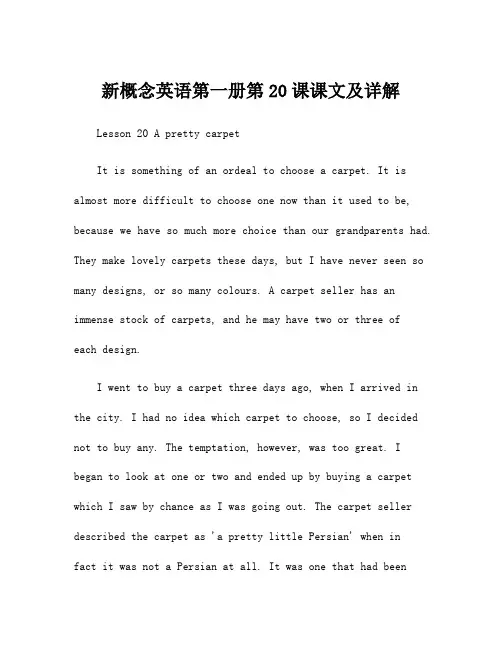
新概念英语第一册第20课课文及详解Lesson 20 A pretty carpetIt is something of an ordeal to choose a carpet. It is almost more difficult to choose one now than it used to be, because we have so much more choice than our grandparents had. They make lovely carpets these days, but I have never seen so many designs, or so many colours. A carpet seller has an immense stock of carpets, and he may have two or three ofeach design.I went to buy a carpet three days ago, when I arrived in the city. I had no idea which carpet to choose, so I decided not to buy any. The temptation, however, was too great. I began to look at one or two and ended up by buying a carpet which I saw by chance as I was going out. The carpet seller described the carpet as 'a pretty little Persian' when infact it was not a Persian at all. It was one that had beenmade in a factory an hour's drive away. The carpet seller would have called any carpet 'a pretty little Persian', but I was not deceived. I did not care what it was called; I was simply attracted by its design and colour. Nevertheless, the carpet seller had a habit of making everyone feel he had got something really special. On the way out, he put his hand on my shoulder and said, 'You've made a good choice, Sir!' I was still wondering whether I had, when I got it back to the hotel. As I was admiring it in my room, a friend of mine came in and admired it too. He asked me how much I had paid for it and I told him the price. 'I am the carpet seller in the city,' he said, laughing, 'but when I sell a carpet, I never tell people the price I paid for it!'【课文讲解】1. It is something of an ordeal to choose a carpet.【译文】挑选一张地毯,真是一场折磨。
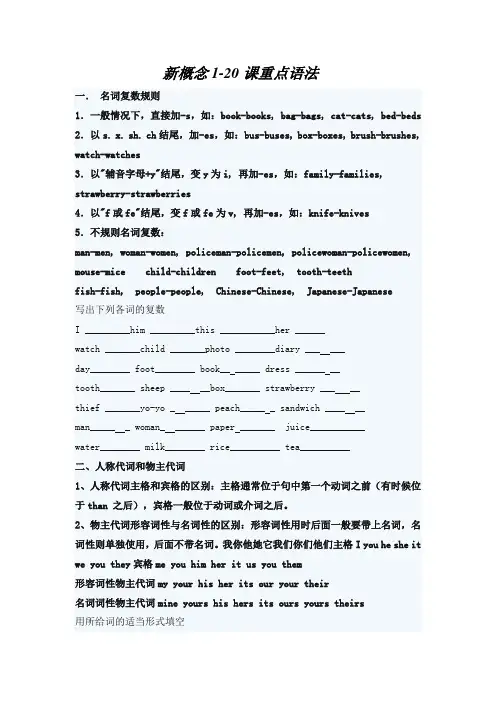
新概念1-20课重点语法一.名词复数规则1.一般情况下,直接加-s,如:book-books, bag-bags, cat-cats, bed-beds 2.以s. x. sh. ch结尾,加-es,如:bus-buses, box-boxes, brush-brushes, watch-watches3.以"辅音字母+y"结尾,变y为i, 再加-es,如:family-families, strawberry-strawberries4.以"f或fe"结尾,变f或fe为v, 再加-es,如:knife-knives5.不规则名词复数:man-men, woman-women, policeman-policemen, policewoman-policewomen, mouse-mice child-children foot-feet, tooth-teethfish-fish, people-people, Chinese-Chinese, Japanese-Japanese写出下列各词的复数I _________him _________this ___________her ______watch _______child _______photo ________diary ___ ___day________ foot________ book__ _____ dress ______ __tooth_______ sheep ____ __box_______ strawberry ___ __thief _______yo-yo _ _____ peach_____ _ sandwich ____ __man_____ _ woman_ ______ paper _______ juice___________water________ milk________ rice__________ tea__________二、人称代词和物主代词1、人称代词主格和宾格的区别:主格通常位于句中第一个动词之前(有时候位于than 之后),宾格一般位于动词或介词之后。
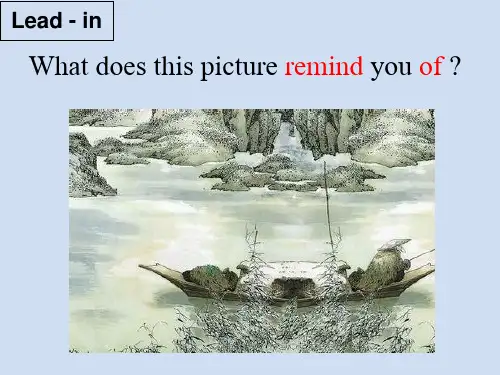
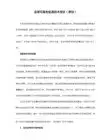

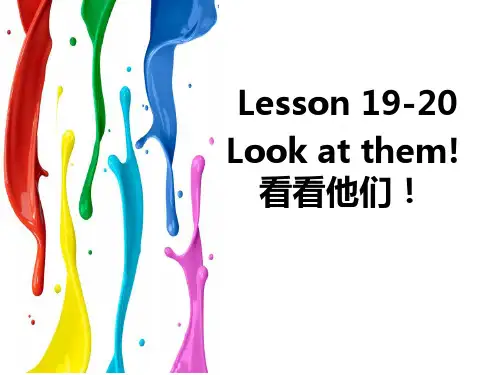
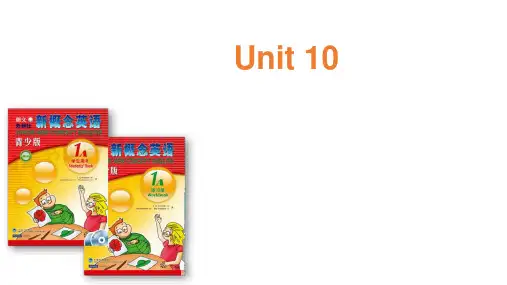
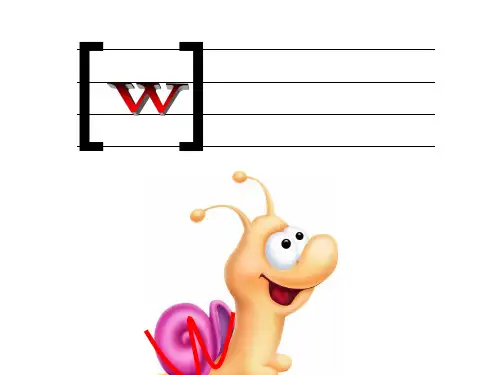
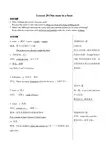
Lesson 20 One man in a boat阅读理解1. Why is fishing the writer’s favorite sport?Because the writer is only interested in sitting in a boat and doing nothing at all.2. What’s the difference between the writer and some unlucky fishermen in terms of fishing? Some unlucky fishermen catch old boots and rubbish while the writer catches nothing.单词详解1. catch v. 抓到(catch – caught – caught)翻译:警方已经抓住了小偷。
The police have already caught the thief.v. 及时赶到,赶上词组:catch the train 赶上火车v. 听见,理解e.g. Sorry, I can’t catch you.2. fisherman n. 钓鱼人,渔民填空:There are many fishermen (fish) by the river.(上海中考)3. boot n. 靴子词组:一双靴子a pair of boots4. waste n. 浪费用法:a waste of …浪费……翻译:这是在浪费时间/金钱/食物/水。
It is a waste of time / money / food / water.vt. 浪费翻译:I’m not going to waste any money on(在……上浪费钱)this ugly coat! 【趣味知识1】Catch-22第22条军规。
源自美国作家约瑟夫•海勒(Joseph Heller)1961年出版的同名小说。
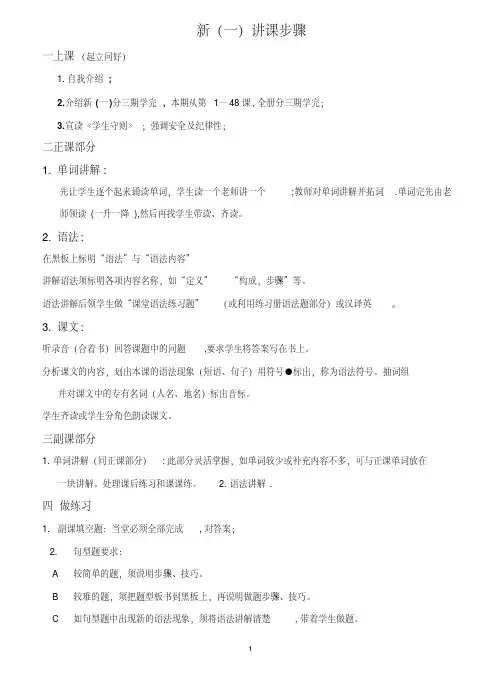
新(一)讲课步骤一上课(起立问好)1.自我介绍;2.介绍新(一)分三期学完, 本期从第1—48课,全册分三期学完;3.宣读《学生守则》;强调安全及纪律性;二正课部分1. 单词讲解:先让学生逐个起来诵读单词,学生读一个老师讲一个;教师对单词讲解并拓词.单词完先由老师领读(一升一降),然后再找学生带读、齐读。
2. 语法:在黑板上标明“语法”与“语法内容”讲解语法须标明各项内容名称,如“定义”“构成,步骤”等。
语法讲解后领学生做“课堂语法练习题”(或利用练习册语法题部分)或汉译英。
3. 课文:听录音(合着书)回答课题中的问题,要求学生将答案写在书上。
分析课文的内容,划出本课的语法现象(短语、句子)用符号●标出,称为语法符号。
抽词组并对课文中的专有名词(人名、地名)标出音标。
学生齐读或学生分角色朗读课文。
三副课部分1.单词讲解(同正课部分):此部分灵活掌握,如单词较少或补充内容不多,可与正课单词放在一块讲解。
处理课后练习和课课练。
2.语法讲解.四做练习1. 副课填空题:当堂必须全部完成,对答案;2. 句型题要求:A 较简单的题,须说明步骤、技巧。
B 较难的题,须把题型板书到黑板上,再说明做题步骤、技巧。
C 如句型题中出现新的语法现象,须将语法讲解清楚,带着学生做题。
D 句型题根据上课具体情况安排,数个至全部在课堂上由学生完成,其余题或典型题留成作业。
五作业:学生应准备三个本,(两个作业本AB,一个听写本)1.课文(正课)背写一遍→家长签字。
收改;2.单词(正课+副课)带音标抄3遍。
汉语一遍收改(前48课第一期,后两期可省去);3.课后练习题(句型题)做在本子上,前5个或一半,收改;4.课课练与本课对应练习完成。
收改;(其中难题在第四部分上课解决)。
5.单词、课文在下次课上分别听写、默写,100分者在听写本上扣章。
6.奖励方法:听写得连续5个一级棒,换一个小博士, 一期结束,看谁得最多有奖品;六其他:1.收测试卷费,订课课练答案;2.严格遵守“喝茶”及“考试、考勤”制度;3. 试卷考完后利用课堂最后的时间进行讲解,考试内容较多的分次讲解。
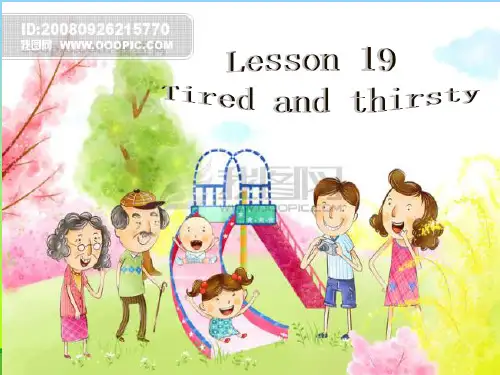
新概念英语第一册Lesson 19-20讲解单词讲解:1.matter n. 事情,事件,麻烦事,困难;V. 有关系,要紧This matter is important to me. 这件事对我很重要。
What's the matter, Anna ?怎么了,安娜?It doesn't matter. 没关系。
2. children n.孩子们(复数)child n. 孩子(单数)kid-kidsChildren love to play in the park. 孩子们喜欢在公园里玩。
3. tired adj. 累的,疲乏的dog-tired 极度疲乏的(累成狗)I am tired. 我很累。
Is he tired? 他很累吗?4.boy n. 男孩The boy loves to play with his toys. 男孩喜欢玩他的玩具。
I am thirsty. 我口渴了。
hungry adj. 饿的6.mum 妈妈dad爸爸7.sit down 坐下stand up 起立8. right1).好的,可以all right=ok-Let's play football.-All right.2). 正确的You are right. 你是对的。
反义词:wrong 错误的3). 右边的on the right 在右边反义词:left 左边的on the left在左边9. ice cream 冰淇淋ice 冰cream奶油;乳酪;面霜10.big 大的,反义词small 小的风大,雨大,雪大用heavy声音大用loud年纪大用old面积大用large11.open1). adj. 开着的反义词:shut 关着的The door is open. 门是开着的。
Please open the door. 请开一下门。
12.shut1). 关着的,停止营业的,相当于closedThe window is shut. 门是关着的。